Birding in Spain: Birding in Catalonia
|
|||||||||||||||||
|
guided birding in spain birding in catalonia day tours short breaks holidays steppes page
|
|
||||||||||||||||
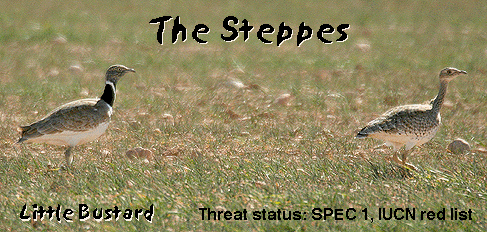 |
|||||||||||||||||
BIRD TOURS : |
TRIP REPORTS : |
EXTRA INFO : |
|||||||||||||||
Same-day Add-ons:
|
|||||||||||||||||
|
|
Photos by Jamie Durrant, Michael Frankling, Stewart Abbott and other tour members |
|
|||||||||||||||
|
|
|
||||||||||||||||
Birding in the Spanish Steppes : |
If you have limited time for a birding trip whilst in NE Spain then Los Monegros and the Steppes of Lleida, which host the last of Catalonia's share of the bustards, sandgrouse and other steppe birds for which Spain is so famous, is the place I'd highly recommend.Steppe lands support more bird species of conservational concern than any other habitat and the severe contraction that the drylands around Lleida have suffered of late (due to irrigation, intensive farming and over-grazing) has caused many of its birds to be added to the IUCN's 'red list of endangered bird species'.But there are also nearby micro-habitats of rivers, lakes and riparian woodland, and in addition Los Monegros provides a not-too-distant alternative, especially for Dupont's Lark, raptors and wintering Great Bustard.In fact, such is the variety of habitat on offer that it's not at all unusual to see over 100 bird species in a single day. Read more... |
Steppes Birding Tours : |
|||||||||||||||
! Lunch !An excellent full home-made picnic based on local cuisine is available at €10 per person |
Lleida Steppes onlyLleida Steppes +
|
||||||||||||||||
Bird Tour Checklist: |
|||||||||||||||||
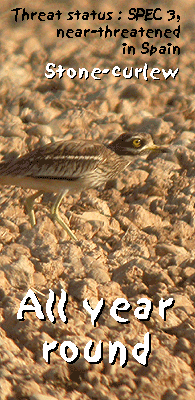 |
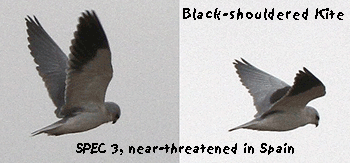 |
||||||||||||||||
Birding in the Spanish Steppes:
|
All year round :
Mallard Red-legged Partridge (2) Pheasant Little Grebe Great Crested Grebe Night Heron (3) Cattle Egret Little Egret Grey Heron White Stork (2) Griffon Vulture (3) Marsh Harrier Goshawk Sparrowhawk Common Buzzard Common Kestrel (3) Peregrine Falcon (3) Moorhen Coot Little Bustard (1) (NT) Stone-curlew (3) Black-headed Gull Yellow-legged Gull Black-bellied Sandgrouse (3) Pin-tailed Sandgrouse (3) Stock Dove Wood Pigeon Collared Dove Little Owl (3) Common Kingfisher (3) Hoopoe (3) Iberian Green Woodpecker (2) Great Spotted Woodpecker Dupont's Lark (3) (NT) |
||||||||||||||||
|
|
|||||||||||||||||
Many clients will testify to the start of a typical birding tour to the Steppes of Lleida... tucking in to early-morning coffee and biscuits watching a flock of car-side Pin-tailed Sandgrouse. Before moving on we've usually picked out Little Bustard skulking at the field boundaries and noted that those boulders with eyes are in fact Stone-curlew.Catching them early is the key, as the seasonal niche-swapping Hen and Montagu's Harriers that often sail by at this hour will verify. This way we have plenty of time not only to find birds such as Black Wheatear, Southern Grey Shrike, Dupont's Lark and Black-shouldered Kite, but also to observe how each is supremely adapted to survive. |
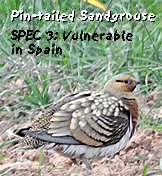 |
||||||||||||||||
|
|
|||||||||||||||||
"We would thoroughly recommend your holidays to anyone.
|
 |
||||||||||||||||
| Calandra Lark (3) Lesser Short-toed Lark (3) Crested Lark (3) Thekla Lark (3) Woodlark (2) Skylark (3) Crag Martin White Wagtail Wren Robin Stonechat (3) Black Wheatear (3) Blue Rock Thrush (3) Blackbird Song Thrush Mistle Thrush Cetti's Warbler Fan-tailed Warbler Blackcap Dartford Warbler (2) Sardinian Warbler Long-tailed Tit Blue Tit Great Tit Coal Tit Short-toed Treecreeper Penduline Tit Southern Grey Shrike (2) Jay Magpie Red-billed Chough (3) Jackdaw Carrion Crow Raven Starling (3) Spotless Starling House Sparrow (3) Tree Sparrow (3) Rock Sparrow |
|||||||||||||||||
|
|
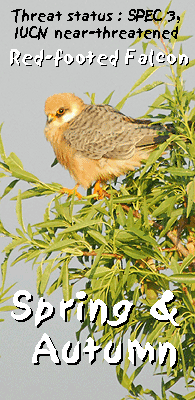 |
||||||||||||||||
Birding in the Spanish Steppes: Spring and Autumn Passage |
|||||||||||||||||
|
|
|||||||||||||||||
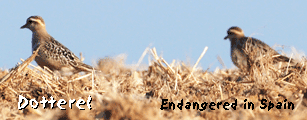 |
|||||||||||||||||
A birding tour during migration will afford opportunities to view many additional raptor and passerine species such as Honey-buzzard, Osprey and Pied Flycatcher as well as the 'all year round' and migrating 'summer' and 'winter' birds.The Dotterel is typical of species attracted to the area on passage, showing Steppe adaptations and, along with Red-footed Falcon, even make use of the same fields each year.And with birds arriving from February (Lesser Kestrel, Great Spotted Cuckoo) to May (Lesser Grey Shrike) and departing from August to October, the migration seasons are perhaps longer than you realise. |
|||||||||||||||||
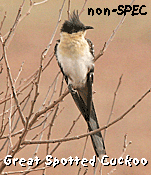 |
|||||||||||||||||
| Spain birding: The Steppes: Spring and Autumn itinerary | |||||||||||||||||
“Well worth the entrance fee, we thoroughly enjoyed it – even the rain! We would never have thought of going where you took us. Your knowledge of which species were where was as good as expected – and we expected a lot! We could not do justice to the meal – not only varied and ‘local’ but at a very reasonable price. Thoroughly enjoyable.”
|
 |
||||||||||||||||
| Serin Greenfinch Goldfinch Linnet (2) Cirl Bunting Rock Bunting (3) Reed Bunting Corn Bunting (2) Passage Only : Black-necked Grebe (nt) Honey-buzzard Osprey (3) Red-footed Falcon (3) (NT) Common Crane (1) Ringed Plover Dotterel (en) Buff-breasted Sandpiper (V) (NT) Green Sandpiper Flava Yellow Wagtail Flavissima Yellow Wagtail Superciliaris Yellow Wagtail (V) Common Redstart (2) Whinchat Northern Wheatear (3) Willow Warbler Pied Flycatcher Summer (and passage) : Quail (3) Purple Heron (3) Black Kite (3) Egyptian Vulture (3) (EN) Short-toed Eagle (3) Montagu's Harrier (vu) Booted Eagle (3) |
|||||||||||||||||
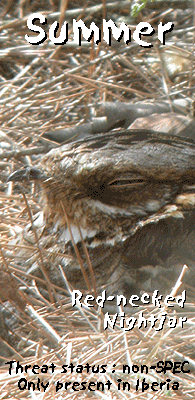 |
|||||||||||||||||
Birding in the Spanish Steppes: Summer (and Passage) |
|||||||||||||||||
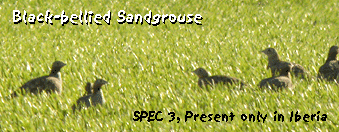 |
|||||||||||||||||
Not many birders would choose to take a bird watching holiday or birding break during the summer but in actual fact the Steppes have a surprisingly lot to offer.The sight and sound of Quail mix it up with bustards and sandgrouse, Rollers roll and Red-necked Nightjars can be observed undisturbed in the leafy floors of the pinedas.In fact many sought-after species are easier to find when settled outside of migration, especially with naive young tempting them out into the open. So watch Penduline Tits nest-building, Red-rumped Swallows playing acrobatics and Magpies feeding adopted Great Spotted Cuckoos. |
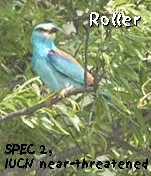 |
||||||||||||||||
"I would recommend your birding tours without hesitation.
|
 |
||||||||||||||||
| Lesser Kestrel (1) (VU) Hobby (nt) Black-winged Stilt Common Sandpiper (3) Turtle Dove (3) Great Spotted Cuckoo Common Cuckoo Red-necked Nightjar Common Swift Pallid Swift Alpine Swift European Bee-eater (3) Roller (2) (NT) Wryneck (3) Short-toed Lark (3) Sand Martin (3) Barn Swallow (3) House Martin (3) Red-rumped Swallow Tawny Pipit (3) Iberiae Yellow Wagtail Nightingale Black-eared Wheatear (2) Reed Warbler Great Reed Warbler Melodious Warbler Western Orphean Warbler (3) Common Whitethroat Spectacled Warbler Sub-alpine Warbler Western Bonelli's Warbler (2) Spotted Flycatcher (3) Golden Oriole Lesser Grey Shrike (2) Woodchat Shrike (2) Ortolan Bunting (2) Winter (and Passage) : Gadwall (3) Teal (v) Shovelor (3) Great Cormorant Great White Egret Red Kite (2) (NT) Hen Harrier (3) Golden Eagle (3) Merlin Great Bustard (1) (VU) Dotterel ** Lapwing (2) |
|||||||||||||||||
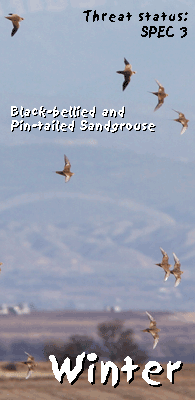 |
|||||||||||||||||
Birding in the Spanish Steppes: Winter (and Passage) |
|||||||||||||||||
 |
|||||||||||||||||
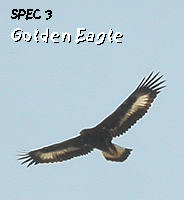 |
|||||||||||||||||
A birding trip in winter is remarkably productive, with less vegetative cover and mid-day heat meaning many Steppe birds are more easily seen out in the open.And flocks of Black-bellied Sandgrouse, Great Bustard, buntings, larks and even Red-billed Chough are rather helpfully boosted by juveniles and an influx of wintering birds from neighbouring hinterlands.And of the raptors, the summer niches are taken up by Hen Harrier and Red Kite, replacing their close cousins, Merlin and Peregrine represent the falcons and numbers of immature Golden Eagles hunting for rabbits soar as first-winters are pushed out of their parental territories. |
|||||||||||||||||
| Spain birding: The Steppes: Winter itinerary | |||||||||||||||||
"Thank you for a great tour. We thoroughly enjoyed ourselves and the species list [172 total] for four days birding was particularly impressive. Our favourite day was the Lleida Steppes. We particularly enjoyed the Red-footed Falcons and voted the Red-necked Nightjars as bird of the trip."
|
|||||||||||||||||
 |
|||||||||||||||||
Common Snipe (3) Meadow Pipit Grey Wagtail Dunnock Black Redstart Ring Ouzel Redwing Chiffchaff Firecrest Chaffinch Key: SPEC 1 (1) |
|||||||||||||||||
The Nature of the Steppes of Lleida... a personal overview |
With the light already fading and arriving at an uncertain location given me by an even more uncertain local, on my first visit to the steppes, I didn't really know what to expect.But two hours later I tore myself away from the pitch-black having seen several species I'd never seen before, including Little Bustard, and had the best birding experience of my life. This is easy I thought!As soon as I had arrived my attention was grabbed by a racket coming from a nearby copse. I recognised the distress calls of the local Magpies but soon also counted thirty-two Great Spotted Cuckoo amongst them.Then, after watching a male Marsh Harrier and revelling in the chinkling of dozens of Calandra Lark, I finally spotted two Stone-Curlew in the field right next to me.My worries that the local shepherd, who was approaching with his flock, would scare them away disappeared when I saw about fifty Spanish yellow Wagtail skipping in and out of their footsteps. Closer examinationrevealed races from Britain, central Europe, and an extremely rare and beautiful black-headed form from Russia, superciliaris.As I was leaving, a female Montagu's Harrier, immediately joined by a hauntingly grey male, decided to float around my head for a while. I was hypnotised.The problem is, as anyone who's ever visited the huge area around Lleida knows, that it's rarely this easy, with frustratingly small populations of birds like Lesser Kestrel, Lesser Grey Shrike and Black-bellied and Pin-tailed Sandgrouse.So, in order to track down migrating Dotterel and Red-footed Falcon, tick off the complete set of Larks, and work my way through Roller, Red-necked Nightjar, Southern Grey Shrike and Penduline Tit, there was no option but to get to know how the birds move and live on a transient land that, over the course of many seasons, changes from fallow to plough to crop to stubble and then back again. |
||||||||||||||||
Six adaptations of Steppe birds... |
4. a tendency to be ground-nesting.5. often adopt song-flights and other aerial displays.6. cryptic colouration of plumage and eggs.1. a tendency to, and having adaptations for, walking or running.2. measures for coping with severe sun or water shortage, such as dust-bathing or crepuscular activity.3. gregarious behaviour, such as flocking. |
||||||||||||||||
Steppes Links : |
Lleidatur/Aiguabarreig (in English) |  |
|||||||||||||||
| Riba-Roja Tourism Agency | |||||||||||||||||
|
|||||||||||||||||

